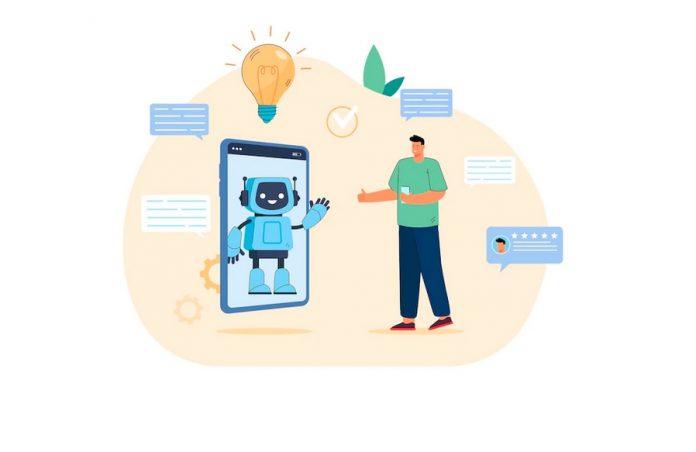Chatbot work in different ways
Artificial conversation entity. How Does Chatbots work and software or computer programs that simulate human conversation and “chatter” through text or voice?
Users of chatbot work like artificial conversation entity.virtual assistants are increasingly using them to accomplish simple tasks in B2C and B2B environments. Organizations can reduce overhead costs, utilize support staff time more effectively, and provide customer service during non-working hours with chatbot work artificial conversation entity. assistants.
What does a chatbot do?
Depending on their complexity, chatbots work can be stateless or stateful. A stateless chatbot approaches each conversation as if interacting with a first-time user. Unlike stateless chatbot work, stateful chatbots can account for past interactions when constructing new responses.
Chatbots are easy to integrate into service or sales departments. Using chatbot service providers, developers can build conversational user interfaces for third-party business applications.
Choosing the right engine is critical to implementing a chatbot. Chatbots Require speech recognition engines if users interact with them via voice, for example.
It is also imperative for business owners to decide whether they want structured or unstructured conversations. A chatbot designed for structured conversations is highly scripted, simplifying programming but restricting what users can ask. Scripted chatbots often respond to commonly asked questions or automate simple, repetitive tasks within B2B environments. Chatbots, for instance, can help sales reps quickly obtain phone numbers.
What is the importance of chatbots?
Artificial intelligence (AI) chatbots are helpful for organizations looking to improve sales or service productivity, as they can converse with users and address recurring problems.
Experts expect chat-based communication methods to grow as consumers move away from traditional forms of communication. It is becoming increasingly common for organizations to use chatbot-based virtual assistants to handle simple requests, allowing human agents to focus on more meaningful tasks.
Is chatbot technology evolving?
In the early days of chatbots, such as ELIZA and PARRY, real people could at least temporarily pretend they were conversing with another person via a program. Testing PARRY’s effectiveness in the 1970s required testers to identify a human vs. a chatbot at the level of making random guesses.
There has been a lot of progress since then regarding chatbots. AI technologies are used to build modern chatbots, including deep learning, natural language processing (NLP), and machine learning algorithms (ML). Data is required for these chatbots in large quantities. Voice recognition improves as an end user interacts with the bot.
Business and consumer markets are increasingly using Crystal Xone chatbots artificial conversation entity. When consumers interact with chatbots, they have fewer arguments to contend with. Chatbots fill a niche previously filled by phone calls due to advanced technology and a shift to passive, text-based communication.
There are several types of chatbots, including:
A chatbot that can be scripted or can respond quickly.
Chatbots operate as hierarchical decision trees at their most basic level. A chatbot interacts with users by asking predefined questions until the bot answers the user’s query.
Similarly, the menu-based chatbot asks users to select from a predefined list to give it a better understanding of what the customer wants.
Chatbots based on keyword recognition.
A chatbot such as this is a bit more complicated; it listens to what the user types and response to the words the customer types. To respond appropriately, this bot combines customizable keywords with artificial intelligence. Repetitive keyword usage or redundant questions are challenges for these chatbots.
I am using hybrid chatbots.
Menu-based chatbots combine elements of keyword recognition bots. A chatbot can answer a user’s questions directly or use a menu to make selections if keyword recognition fails.
Contextual chatbots.
The complexity of these chatbots necessitates a data-centric approach. They remember user interactions and conversations using AI and ML, allowing them to grow and improve over time. In contrast to keywords, these bots operate the customer’s questions and ask them to provide answers and improve themselves.
Automated chatbots that can speak.
The future of this technology lies in this type of chatbot. With voice-enabled chatbots, users talk to prompt responses or creative tasks. A text-to-speech API and a voice recognition API can be used to create these chatbots. Apple’s Siri and Amazon Alexa are examples.
How can chatbots benefit your business?
Furthermore, organizations gain various benefits from chatbots in addition to improving customer experience. The likelihood that an organization will profit from loyal customers increases with improved Crystal Xone and more satisfied customers, thanks to chatbots.
There are also the following benefits:
It is possible to hold multiple conversations at the same time. Thousands of buyers can be conversed with simultaneously by chatbots. As a result, waiting times are eliminated, and business productivity is increased.
-
Cost-effectiveness.
Creating a cross-platform app or hiring more employees is more expensive and time-consuming than building a chatbot. Human error can also be reduced by using chatbots. Chatbots’ ability to respond within seconds decreases user acquisition costs as well.
-
Time is saved.

It is possible to automate tasks performed frequently and at specific times with chatbots. Employees are freed up to work on more critical studies, while customers don’t have to wait for responses.
Interaction with customers on a proactive basis. Past customer interactions have been passive, and organizations have waited for buyers to reach out first. By integrating chatbots into websites and landing pages, organizations can engage with customers proactively, initiating conversations and monitoring customer behaviour. Monitoring can then offer specific incentives to buyers, assist users with navigation, and answer future questions.
Monitoring and analyzing consumer data.
Businesses can improve their products and services by using chatbots, which collect feedback from every interaction. In addition to providing insight into how to market their products and services better, this information can help organizations understand common obstacles customers face during the buying process.
Engages customers more effectively. The majority of companies already engage their customers through social media. Interactivity can be enhanced by chatbots. Chatbots allow customers to communicate with businesses without having to interact since they rarely talk to people inside a company.
The product is scalable to global markets. Chatbots can use multiple languages to answer customer questions and concerns. No matter what time or zone the customer is in, they are available 24/7.
Increases customer base. Chatbots can generate leads, qualify them, and nurture them. A chatbot works artificial conversation entity. can provide information likely to persuade the user and create a leader throughout the buyer’s journey. Using chatbots, sales teams can gather information about potential customers who the sales team can engage.
Qualifications of leads are measured. A chatbot works artificial conversation entity. can help sales teams determine a lead’s capability based on key performance indicators. Companies can avoid wasting time on unqualified leads and time-consuming customers.
How do chatbots present challenges?
In addition to improving customer experience and bringing benefits to organizations, chatbots also present several challenges.
The following are some of these challenges:
As technology advances, new obstacles arise. Chatbots are still a relatively new technology and may face barriers that organizations aren’t aware of. The use of AI-enabled chatbots can improve their behaviour over time, but the first few interactions can cause customers to disengage and leave the company.
- Safety. Hackers should not be able to access chat interfaces through chatbots with secure designs.
Types of messages vary from person to person. The artificial conversation entity chatbot must handle both long and short sentences and multiple short submissions versus a single long sentence.
Humans communicate in a variety of ways. An artificial conversation chatbot may have difficulty understanding these variations. There is also the possibility that the user uses slang, misspells words, or uses acronyms.
Emotions, moods, and behaviour of people are unpredictable. They can give a command rather than a suggestion once they have asked for advice. It is always their goal to make the chatbot better than it is currently. To make users feel as though they’re speaking with a trustworthy, competent source, organizations employing chatbots should continually update and improve them.
Chatbots in the future
Artificial intelligence and machine learning will continue to evolve, allowing chatbots to gain new capabilities and customer experiences through text and voice.
IT ecosystems also include voice services as ordinary and necessary components. In recent years, many developers have focused more on building voice-based chatbots capable of understanding several languages. Responding in those languages, as well as acting as conversational agents.






